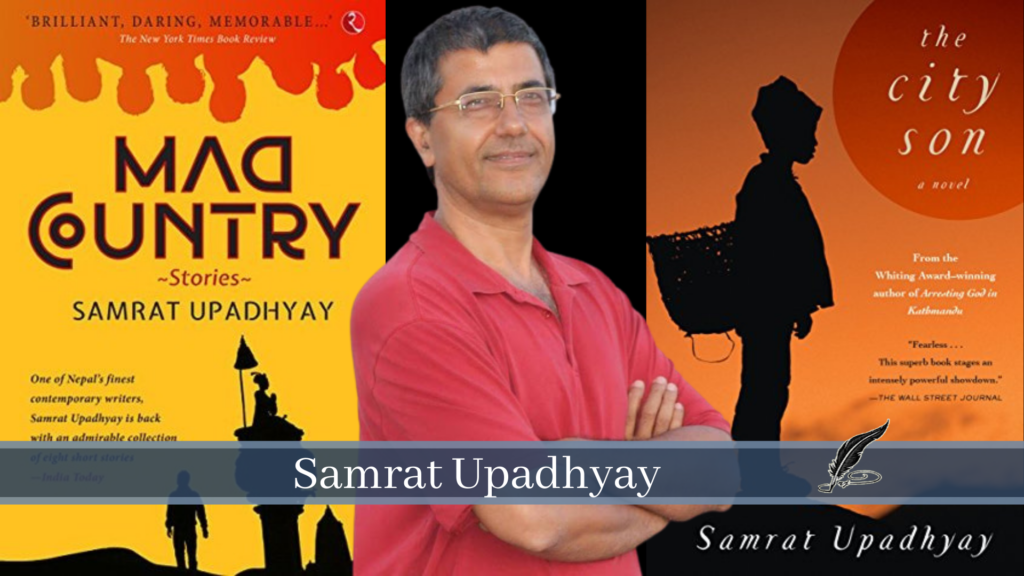
Top 6 Books by Samrat Upadhyay From Nepal
The author of Arresting God in Kathmandu, Samrat Upadhyay, is the first Nepali writer to be published in the US. He’s the first Nepali-born fiction writer who writes in English. Samrat Upadhyay’s books have been translated into many languages, mainly French and Greek.
Upadhyay’s finest work includes “The Guru of Love,” which received the Asian American Literary Award and won the 2001 Whiting Writers’ Award in Fiction. He also received the IU Bicentennial Medal for his distinguished contributions to Indiana University.
Upadhyay represents the social, political, and cultural customs of the Nepalese society through his writing. The engaging protagonists from his books belong to daily life in Nepal.
“I am moved by a writer like Dickens, who also tells grand stories, those emphasizing the human condition.”
Samrat Upadhyay’s books explore the intimate moments of the Nepali people’s lives, mainly belonging to the middle-class in Kathmandu. His writing depicts the struggles, compromises, sacrifices the Nepali community has undergone due to so-called customs and culture aging centuries.
“Once we begin to prescribe our own version of Nepali-ness for Nepali writers, we become didactic and moralistic-bad stuff for writers.”
Here are 6 of the best Samrat Upadhyay books that you must read.
1. Arresting God in Kathmandu
I don’t think all that much. What’s there to think about? Life is what God gives us.
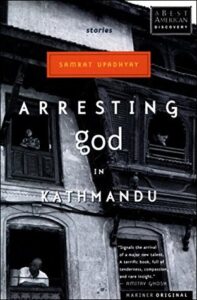
Arresting God in Kathmandu reflects the new generation’s desires and spirituality as Nepal’s family-driven society is transitioning to an unconventional, modern, and individualized future.
The novel consists of nine separate stories, each dealing with the themes of love, conflict, hate, lust, jealousy, remorse, nonconformity, and rationality.
Through Arresting God in Kathmandu, Upadhyay gave the voice to the people residing in Nepal. His characters, their situations narrate the lives of the people living in Kathmandu, especially those who dream of the American lifestyle and freedom. They are living in an inflexible socio-cultural society where family defines their status. The family elders determine their future, and women can’t exercise their freedom to marry whoever they want.
The novel is set in the native streets of Kathmandu and involves characters who have traveled to America at least once, thus giving a fusion of different personalities.
Upadhyay migrated to the US at the age of 22 and has observed most Nepalese immigrants struggling to balance their family traditions with what they thought of the American dream.
The characters is Samrat Upadhyay’s books are mostly found in the conflict and are intertwined by the common threads of feebleness and rationalization. People, especially the youth, are on their journey to modernization yet restrained by traditions, norms, values, and religion.
Michelle Della Giovanna has beautifully reviewed Arresting God in Kathmandu, commending how Samrat made sure each character of his stories is brilliantly executed without any judgments. There are no heroes or villains ‒ every character tries their best to handle the situations in given circumstances.
2. The Guru of Love
If you’re happy and you know it, Think again.
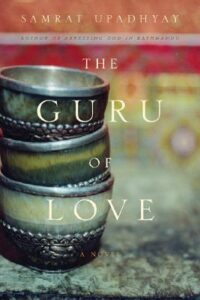
If you’re a complete novice to Nepal’s rich culture, then this novel will make you fall in love with the country. The story shares the rich festive lives of the Nepalese. It revolves around their celebrations and religious sacrifices depicting decorated streets during festivals and the custom of elders gathering at one place. The novel depicts the tight binding of norms and traditions in their lives.
The stories also touch the theme of love and lust in human nature through the protagonist, Ramachandra. Despite being married, he indulges in an affair with his young female student, Malati. The story revolves around the psycho-emotional drama that changes the lives of Malati, Ramachandra, and his wife, Goma.
Upadhyay’s excellent characterization makes you sympathize with Goma naturally. However, you will also feel sorry for Ramachandra when you understand his predicament.
The other part of the novel highlights interesting facts about the cultural and societal differences in Nepal. In the book, Kathmandu has become the place of protests, massacres, and riots for the sake of finding democracy in the country. People have become conscious of personal liberty, women’s rights, freedom to vote, and speech.
The novel characters are very concerned about the status quo and their identities; those with wealth strive to show off their fortunes while the deprived ones try everything to hide their lower-class.
Frederic and Mary Ann Brussat’s review of The Guru of Love makes an interesting point that Ramchandra’s wife’s actions made her husband’s infidelity a spiritual journey for all.
3. Buddha’s Orphans
This is a country where even widows and abandoned wives dared not express any longing for men.
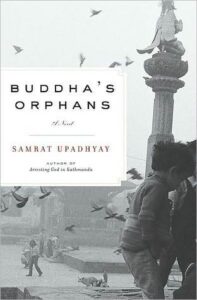
Samrat Upadhyay’s books always touch upon Nepal’s political climate, deep-rooted culture, and struggling relationships that begin with insecurities and convictions and eventually lead to joys, love, and unity.
Buddha’s Orphan is a beautiful combination of six decades-long political disruptions in the country. It’s also a love story between our protagonist Raja, an orphan, and Nilu, who hails from the upper-class. The novel will entertain you with Nepali and Bengali cultures, their colloquial slangs of endearment, traditional foods, dresses, and pursuit of the daily routine life in Nepal.
The novel’s central idea lies in the universal truth about human existence that nobody can escape: birth, death, and life’s suffering.
After facing condemnation and disapproval by the elders for the personal decision to marry each other, Raja and Nilu are on the path to break the stereotypes about arranged marriages and matchmaking services.
Raja is strongly opposed to the monarchy in the country. Hehe actively participates in political riots until he faces the death of his a-few-months-old son when Nilu is unable to arrange medication for him due to road blockage by the uprisings in the city. This devastating incident changes the course of life for the married couple.
Upadhyay has excellent skills to arouse the readers’ curiosity that keep them turning the pages to see what’s coming next.
The novel includes many complexities that Nepal, as a country, went through; political unrest, protests against the monarchy, and struggle for democracy. The writer also touches upon magical realism by creating a connection to the departed souls.
In his review of Buddha’s Orphan, I agree with Stephen that Upadhyay gives us real insights into the culture, traditions, norms, and values of the country that are often overlooked by authors who write about pan-ethnic rubrics of Asian-Americans.
4. The Royal Ghost
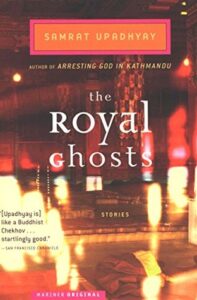
This book highlights how familial responsibilities can become a hurdle in fulfilling personal desires in Nepal’s rigid domestic society.
The Royal Ghost is a fine collection of nine short stories set in the transforming urban environment of modern-day Kathmandu. The themes include complex issues like inter-caste marriage, Maoist violence, homosexuality, and mental health.
The novel follows the country’s biggest turmoil of the century – the royal family’s massacre in 2001. Most of the characters are haunted by the loss of familial relations.
For instance, Pitamber, the protagonist from the first story, risks his family equilibrium when he gives shelter to a widow when her husband is murdered. However, this act of kindness backfires, and he ends up souring his relationship with his family. Another story follows a wealthy bachelor who is kind enough to arrange a grand wedding party for his servant, but a disaster is waiting for them post-wedding.
These alluringly supple and somewhat humorous stories are a perfect read for anyone interested in a native-like experience in Kathmandu.
I agree with this review of The Royal Ghost that it’s difficult to quantify the depth of emotions that Upadhyay has put in his stories.
5. Mad Country
You find yourself in another dimension, and you are still you, but the world around you has suddenly changed colors.

This book by Samrat Upadhyay revolves around one central theme that binds all these phenomenal seven stories and one novella, searching for an identity. Identity crisis evolves, changes, develops the plots and resolves the novel’s conflicts.
The other themes are political unrest, class distinction, race struggles, and personal freedoms. These captivating stories depict Nepal’s elite class’s experiences during the political upheaval and the immigrant experience of Nepalese in the US.
The very first story reveals the suppression of the free press in Nepal. He introduced the daunting character of Shalini, a journalist who faces threats and later disappears while investigating the rooted corruption in Nepal.
Upadhyay explores the class division and identity crisis in Nepal through another character Ramesh who belongs to a well-to-do family but feels misfit and practices being poor by becoming a beggar boy. His obsessed fantasies and unpolished fascination will lead the story to unexpected results.
In the story, Dreaming of Ghana, Upadhyay hints at the vagaries and unfulfilled desires of the youth when Akash, the protagonist, dreams of Ghana when he is unaware of any such country existing in Africa. Then something bizarre happens, and Akash is connected to a mysterious foreign black girl.
Sofi, an American girl who falls in love with Nepal, its beauty, and culture, insists on living in the country, forgetting about America betraying her true identity.
Almost every story ends with peripeteia ‒ the reversal of fortune or the life-changing moment in our protagonist’s life. Upadhyay has interconnected the world’s opinion over Nepal into his remarkable seven stories and one novella.
I agree with Gourley in his review of Mad Country that Upadhyay doesn’t only show you the nature of life in Nepal but also relates to the world’s point of view for the people belonging to Nepal.
6. The City Son
Hell hath no fury like a woman scorned.
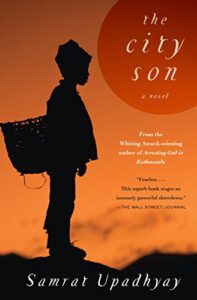
I wouldn’t recommend this book to those who are sensitive to content about child molestation. Nonetheless, it’s an intriguing book packed with deep, dark, and witty humor discussing betrayal and abuse.
This novel is indeed an explosive book. The dramatic story begins from the first few paragraphs without meaningless digressions when an unnamed woman discloses to Didi (the protagonist of the novel) about her husband Masterji’s illegitimate relationship.
The novel highlights the complexities of Didi’s psycho-emotional condition. Didi has forgiven her husband, but deep down, she suffers from chronic psychological distress that slowly drives Aspara (Masterji’s second wife) to sheer madness.
Didi’s domineering attitude towards household chores and her emotional and physical advancement towards her stepchild would haunt the family until someone stops this nightmare.
Upadhyay has used many staggering and disturbing language to narrate the story, keeping the reader on edge, allowing them to enjoy every moment of the novel.
I agree with Jairam Mohan’s advice in his review of The City Son that this book packs value for readers who prefer books about complex human relationships.
We welcome you on a journey around the world as we explore works of 80 cherished authors around the world. We list their famous books, give you an overview, and connect you to the best book reviews by readers like you and me so that together we can learn stories from around the world.
Find more author reviews here